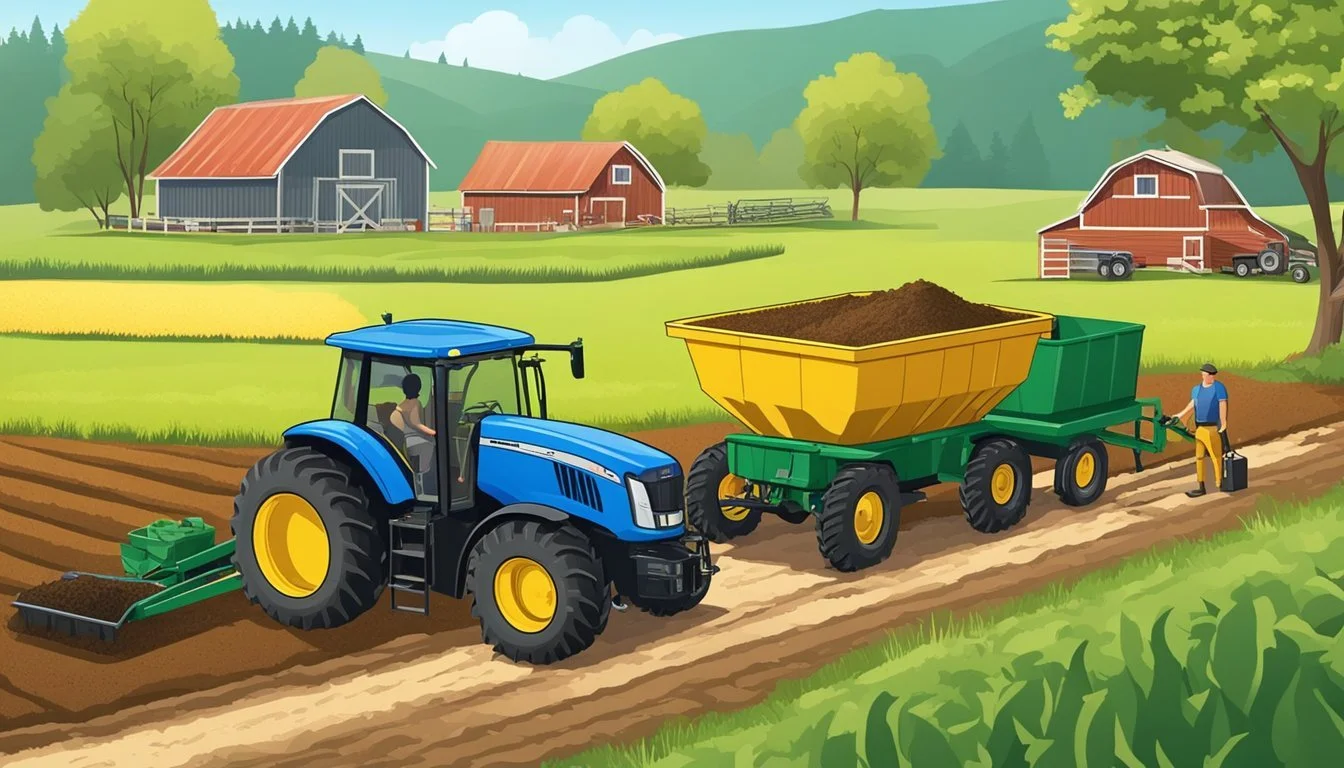The Ultimate Guide to Using a Manure Spreader
Optimize Your Soil Fertility in Homestead Farming
In the realm of homesteading and small-scale agriculture, efficient field fertilization is paramount for maintaining soil health and maximizing crop yield. A manure spreader is a vital piece of equipment for this purpose. Its design allows for the even distribution of manure across fields, providing essential nutrients such as nitrogen, phosphorus, and potassium to the soil. These nutrients are fundamental for plant growth, fostering robust crops throughout the growing season.
Manure, a byproduct of livestock farming, serves as a rich, organic fertilizer that can improve soil structure and fertility. Implementing a manure spreader in homesteading practices not only recycles waste but also contributes to a more sustainable and eco-friendly approach to agriculture. By evenly spreading manure, a spreader ensures that plants receive a uniform distribution of nutrients and that the risk of burning or over-fertilizing certain areas is minimized.
The utilization of a manure spreader comes with numerous advantages. It expedites the process of manure application, saving time and labor, and also helps in reducing nutrient loss to the environment. Proper use of this equipment involves calibrating application rates according to crop nutrient needs and soil testing results, thereby optimizing fertilization efforts and contributing significantly to the success of homesteading activities.
Understanding Manure Spreaders
Efficient field fertilization with manure spreaders involves knowing the different types of equipment available and their specific mechanisms. A manure spreader's capacity, the type of manure used, and the tractor's power affect the operation's speed and the spreader's performance.
Types of Manure Spreaders
Solid Manure Spreaders: This category includes both flail spreaders, which use a series of flails to chop and spread the manure, and side discharge units, which spread the manure to the side as they move across a field.
Capacity: These spreaders come in various sizes, ranging from small units suitable for homesteads to large-scale industrial models.
Speed and Performance: The distribution speed and evenness can vary with different models, impacting the overall efficiency of soil enrichment.
Tractor Requirement: A tractor's power take-off (PTO) may be used to operate the mechanism, requiring an appropriate tractor size and power for optimal use.
Liquid Manure Spreaders: Such spreaders are designed to handle liquid manure, typically equipped with a tank and an applicator system to distribute the manure across the field.
Volume Considerations: They are measured by volume capacity, indicating the amount of liquid manure they can hold and apply per given time.
Application Technique: The applicator system may include topsoil style spreaders and general liquid manure applicators to ensure a uniform application.
Components and Functionality
Manure spreaders consist of several key components that work together to achieve effective manure distribution:
Hopper: The container where manure is held before spreading.
Spreading Mechanism: Different types might include flails or beaters for solid manure, or hoses and nozzles for liquid manure.
Conveyor System: Moves the manure from the hopper towards the spreading mechanism. It may be powered by hydraulics or the tractor's PTO.
Control System: Allows the operator to manage the rate of manure distribution to match desired application rates.
The tractor plays a central role in driving the manure spreader, with the PTO commonly used to power mid-sized to larger spreader mechanisms. The size of the spreader is directly correlated to the load capacity, and it's critical to match the spreader size with the tractor's capabilities for efficient operations. Calibration is key to ensuring that the manure is spread at the intended application rate, maximizing manure usage and improving the fertility effects on the soil.
Preparing for Manure Application
The success of manure application on homestead fields hinges on meticulous preparation. Proper handling and precise calculation of manure rates ensure a beneficial spread of nutrients.
Manure Storage and Handling
Before applying manure, one must consider the storage and handling practices to preserve its nutrient content and ease the application process. Storage should prevent nutrient loss and leaching, while handling should ensure consistent texture and composition for even spreading. A homesteader must ensure their storage facility allows for easy loading and cleaning, and consider the incorporation of bedding materials, which can absorb excess moisture and add to the organic matter content.
Dry Storage: Should allow ventilation to prevent overheating and degradation of nutrients.
Liquid Storage: Must be sealed to prevent leaching and have a system for agitation to keep the nutrients evenly distributed within the liquid.
Proper handling also involves safeguarding the manure against environmental contamination. When manure is ready for application, its transfer from the storage to the spreader should minimize spillage.
Calculating Manure Application Rate
Calculating the correct manure application rate is crucial for efficient field fertilization. This involves assessing the nutrient needs of the upcoming crop and the nutrient content of the manure.
Manure Analysis: Obtain a manure analysis to know the precise nutrient content—especially the levels of nitrogen, phosphorus, and potassium.
Soil Testing: Analyze soil to determine existing nutrient levels and additional nutrient requirements.
Application Rate Calculation:
Match the amount of nutrients in the manure with crop needs.
Account for the nutrient value of organic matter and the existing nutrients in the field.
A homesteader must consider the spread pattern to ensure uniform application across the field. They should calibrate the spreader to apply manure evenly and at the desired rate to avoid over-concentration in certain areas, which could lead to nutrient runoff or crop damage. Here is a sample table that could be used to log application rates per acre:
Application Area (Acre): 1, Manure Type: Solid, Application Rate: 20 tons
Application Area (Acre): 1, Manure Type: Liquid, Application Rate: 5,000 gallons
Application Area (Acre): 1, Manure Type: Poultry, Application Rate: 3 tons
These rates must be tailored to the specific manure type and the results from the manure and soil analyses. Homesteaders should follow local regulations to minimize environmental impact and maintain soil health.
Optimal Manure Spreading Techniques
Achieving efficient field fertilization requires precise spreader setup and uniform nutrient distribution. By focusing on spreader settings and calibration as well as maximizing nutrient distribution, one can ensure effective use of manure on the fields.
Spreader Settings and Calibration
The heart of successful manure spreading starts with the spreader settings and calibration. It is critical that the spreader is configured to distribute manure at the desired application rate, which can vary by crop needs and soil types.
Ground Speed: Adjusting the spreader to match the tractor's ground speed is essential to ensure consistent output. If the spreader dispenses too slowly or quickly relative to movement, application will be uneven.
Terrain Consideration: For hilly terrains, setting the spreader to avoid application on slopes greater than 15% is advisable to prevent runoff and uneven distribution.
Calibration: One must check and calibrate the spreader regularly. Calibration involves verifying that actual manure application rates correspond to those planned, considering variables such as manure type and moisture content.
To calibrate a manure spreader, record the amount of manure loaded and the distance covered, then adjust the settings accordingly.
Maximizing Nutrient Distribution
Uniform application is key to effective manure spread. A uniform spread ensures that all areas receive the necessary nutrients without over-fertilizing certain patches, which can be harmful to soil health and crop growth.
Uniform Distribution: Utilize systems that promote even spreading across the entire width of the spreader. Overlap areas should be managed to maintain consistency.
Nutrient Levels: Homesteaders should test manure for nutrient levels beforehand to fine-tune application rates and match the nutrient needs of the soil and crops.
A proper understanding of spreader mechanics and careful adjustment for specific field conditions enable homesteaders to use manure spreaders to their full potential, promoting sustainable agriculture practices.
Maintaining Your Manure Spreader
Proper maintenance of a manure spreader is crucial for ensuring efficiency, sustainable farming operations, and the safety of those using the equipment. Keeping a manure spreader in good working condition involves routine checks, thorough cleaning, and addressing wear and tear issues in a timely manner.
Routine Checks and Cleaning
Daily Maintenance: Before use, one should inspect hitches, tires, and moving parts for wear or damage. After use, removal of manure from all parts of the spreader, especially around the beaters and moving components, prevents corrosion and ensures longevity.
Maintenance Task: Check tire pressure, Frequency: Daily, Notes: Maintain manufacturer’s specs
Maintenance Task: Lubricate moving parts, Frequency: Weekly, Notes: Use recommended lubricant
Maintenance Task: Inspect for loose bolts, Frequency: Weekly, Notes: Tighten as required
Maintenance Task: Clean spreader thoroughly, Frequency: After each use, Notes: Pay attention to hidden areas
Calibration Checks: Regular calibration of the spreader is vital for precise manure application. Efficient use of nutrients relies on a well-calibrated machine. Check calibration settings against the manufacturer’s guidelines and adjust as necessary.
Wear and Tear Management
Component Inspection: Components such as the spreader chain, beater bars, and box panels are at risk of wear. They should be examined regularly for signs of fatigue, and replaced as needed to prevent failure during operation.
Repair and Replace: Damaged or worn parts compromise the efficiency and safety of the manure spreader. One should ensure timely replacement of parts like paddles, tines, and flooring according to the manufacturer’s recommendations.
Spreader chain: Check for - Stretched links, Replacement Indicator - Difficulty in material flow
Beater bars: Check for - Bent or broken bars, Replacement Indicator - Inefficient spreading
Box panels: Check for - Corrosion or holes, Replacement Indicator - Risk of leaks and loss of material
Remember, consistent maintenance ensures the manure spreader functions at its best, supporting a sustainable and productive farming operation.
Environmental Considerations and Best Practices
When using a manure spreader in homesteading activities, it is critical to address environmental challenges such as nutrient runoff and soil erosion while ensuring soil and water are protected. Implementing best practices can reduce the environmental impact of manure as an organic fertilizer.
Minimizing Nutrient Loss
Timing and Methods: Applying manure at times when crops can readily use the nutrients, such as shortly before planting season, minimizes the chance for nutrient loss through leaching or runoff. Utilizing advanced spreader technology can ensure an even distribution of manure, enhancing its efficiency as a fertilizer.
Soil Testing: Regulate application rates based on soil nutrient testing to prevent over-fertilization, which can lead to excessive nutrient runoff into nearby water bodies.
Buffer Zones: Establishing vegetated buffer zones around fields can trap potential runoff, preventing nutrients from reaching waterways.
Cover Crops: Planting cover crops can absorb excess nutrients that might otherwise leach into groundwater or be subject to erosion.
Protecting Soil and Water
Manure Management Plans: Developing a detailed plan based on the size and type of the operation can ensure efficient use of manure, reducing the risk of environmental pollution.
Composting: Composted manure stabilizes nutrients and reduces pathogens that might contaminate water sources.
Infrastructure Maintenance: Maintaining manure storage and handling systems can prevent accidental spills that contribute to water contamination.
Education and Training: Regularly updated education for farm staff about manure management can help maintain awareness of potential environmental issues and foster a culture of stewardship.
By adhering to these practices, homesteaders can efficiently utilize manure spreaders for field fertilization while honoring environmental responsibilities.
Manure Application in Various Agricultural Contexts
Manure spreading is a critical operation for maximizing soil fertility and crop yield. Proper application can significantly enhance nutrient content in the soil while adapting to the specific demands of various crops and terrain challenges.
Adapting to Different Crop Types
Different crops have unique nutrient demands which dictate the manner in which manure should be applied. For instance, corn typically requires more nitrogen than soybeans, which can fix nitrogen from the atmosphere. Here's how manure application can vary:
Nitrogen (N): Necessary for leaf growth, especially in corn. Excessive nitrogen for soybeans can hinder their ability to fix atmospheric nitrogen.
Phosphorus (P): Essential for the energy transfer within plants, often applied for root crops.
Potassium (K): Important for overall plant health, with crops like potatoes having a higher potassium requirement.
The application rate therefore should be tailored to match the nutrient content of the manure with the crop needs. For example, wheat may prosper with a manure application that emphasizes phosphorus for strong root development.
Handling Diverse Terrain Challenges
Manure spreaders must navigate varied terrains, impacting manure distribution and soil health. Some considerations include:
Flat Terrain:
Ideal for uniform manure spreading.
Risk of runoff is lower, which helps in preserving nutrient content.
Sloped Terrain:
Greater risk of nutrient runoff.
Essential to spread manure on slopes less than 15 percent to prevent soil erosion and nutrient loss.
In each scenario, understanding the soil fertility and nutrient demand ensures that manure is applied efficiently. For example, on sloped terrain, it's crucial to avoid over-application which can lead to runoff, depriving the soil of valuable nitrogen, phosphorus, and potassium.
By considering the specific crop yields and soil health requirements, homesteaders can deploy manure spreaders that respect the nutrient content and improve the overall effectiveness of field fertilization.
Innovations and Advanced Manure Spreading Technology
In the realm of homesteading, the integration of emerging technologies into manure spreading practices is significantly enhancing efficiency and environmental stewardship.
Precision Agriculture Tools
Precision agriculture tools have revolutionized manure application. GPS technology ensures accurate manure placement, reducing waste and environmental impact. Farmers employ calibration kits to optimize the use of manure spreaders, ensuring consistent application rates. This level of precision supports soil health and can lead to better crop yields.
Automated Spreading Systems
Automated spreading systems represent a significant leap forward. PTO-driven spreaders are now increasingly automated, enabling more uniform distribution of manure. Progressive systems incorporate injection methods which directly incorporate manure into the soil, minimizing odors and nutrient runoff. Moreover, modern mobile applications grant the operator remote control over equipment like traveling gun applicators, streamlining the process and allowing for real-time adjustments.
Economic Considerations for Manure Spreader Use
When investing in a manure spreader, prospective buyers must consider the balance between the initial cost and potential long-term benefits. Productivity gains, cost savings, and market options all play pivotal roles in economic decision-making.
Assessing Manure Spreader Investment
Initial Cost: The upfront cost of a manure spreader can vary widely based on capacity, compatibility with existing machinery, and additional features. For example, PTO (Power Take-Off) manure spreaders are often larger and more suitable for big operations, thus costing more. However, ground drive models may offer a more economical choice for smaller farms.
Longevity and Maintenance: Durability is a cost-saving consideration. Modern spreaders with poly-vinyl floorboards resist moisture and decay, potentially reducing maintenance costs over time.
Compatibility: Matching the manure spreader to existing farm machinery enhances productivity while avoiding additional costs. Ensuring that the chosen spreader works with the farmer's tractors or vehicles is crucial.
Cost-benefit Analysis
Productivity Increases: By automating the distribution of manure, a spreader increases work speed and can cover larger areas in less time compared to manual spreading, significantly boosting productivity.
Nutrient Management: Accurately calibrated manure spreaders ensure proper nutrient distribution. This precision avoids over-use of manure and maximizes its effectiveness as fertilizer, contributing to better yields and potential for cost savings in commercial fertilizers.
Market Comparison: Farmers should explore the market thoroughly to identify the best manure spreader for their needs. Factors to consider include warranty, after-sales service, and reviews from existing users. The best option often balances price with functional necessity and potential return on investment.
By carefully considering these economic aspects, farmers can choose a manure spreader that not only fits their budget but also enhances their field management and long-term financial sustainability.
Practical Tips and Common Pitfalls
For an efficient manure spreading process, it's essential for operators to leverage their experience, understand equipment settings and maintenance needs, and apply best practices to avoid common issues.
Effective Manure Spreading Strategies
Manure spreading efficiency relies on uniform application. Operators should possess practical experience to handle variations in spreader performance. The beater systems are critical for an even spread; their settings impact spread width and consistency. To optimize operations:
Lane Spacing: Maintain proper lane spacing to prevent over-application or missed areas; this typically means overlapping wheel tracks by a few inches.
Spread Pattern: Adjust spread pattern settings to match the load consistency, ensuring uniform distribution across the field.
Tarp Use: Covering the load with a tarp can reduce loss during transport and help contain the material until spread.
Maintenance: Regular maintenance, including inspection of beaters and other spreader components, is crucial to prevent breakdowns and ensure longevity.
Troubleshooting and Problem Solving
Even with experience, operators may encounter challenges. Identifying and addressing these promptly is key:
Uneven Spreading: If patches of field receive too much or too little manure, recalibrate spreader settings and inspect beaters for wear or blockage.
Use of Rain Gauges: Install rain gauges to inform decision-making, as wet conditions can affect manure application and nutrient uptake.
Plastic Sheeting: In case of solid manure, using plastic sheets beneath the pile can facilitate easier cleanup and nutrient retention.
Regularly checking the equipment for issues will preempt many problems. If spreading issues persist, consult with the equipment manufacturer or local agricultural extension service for expert advice.




